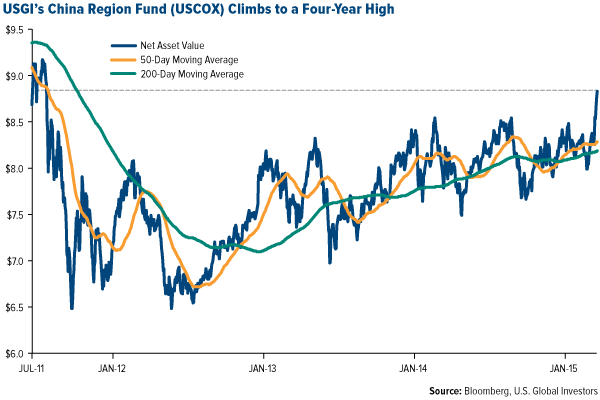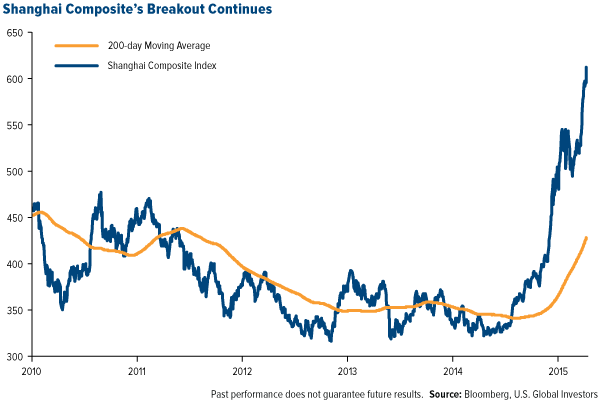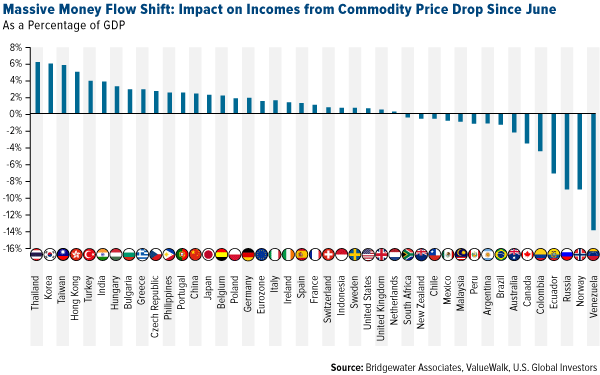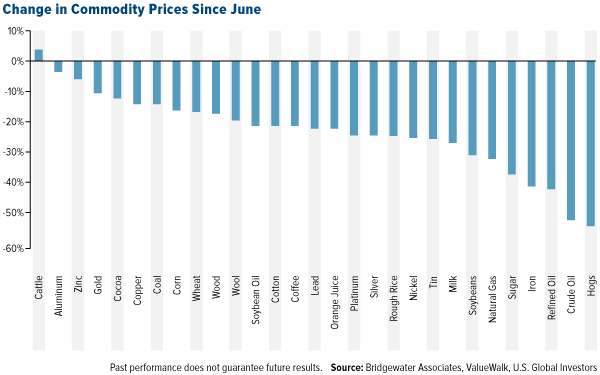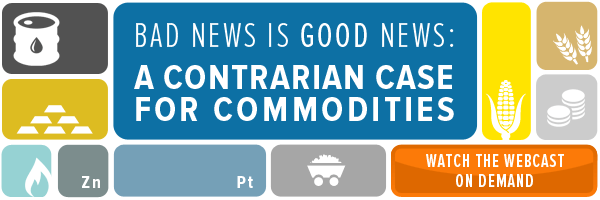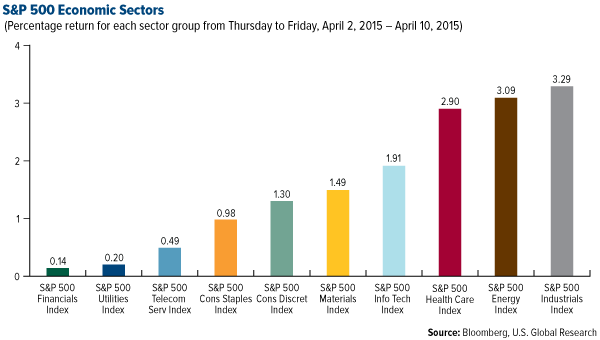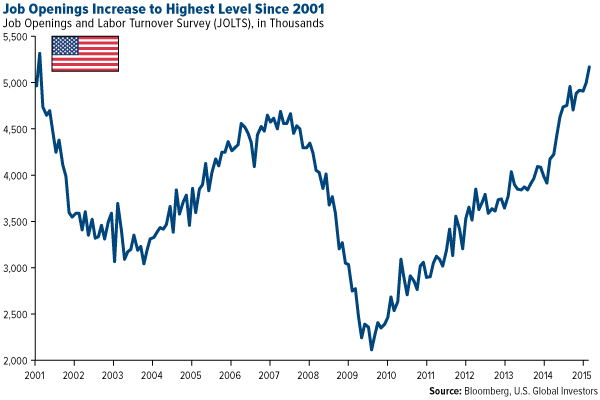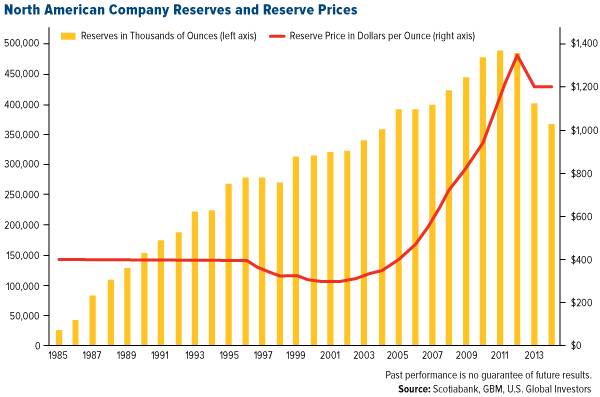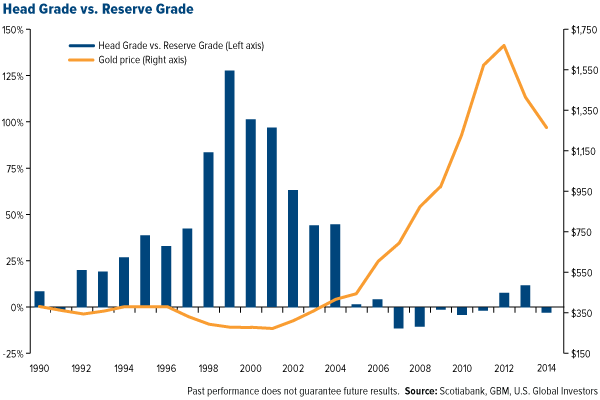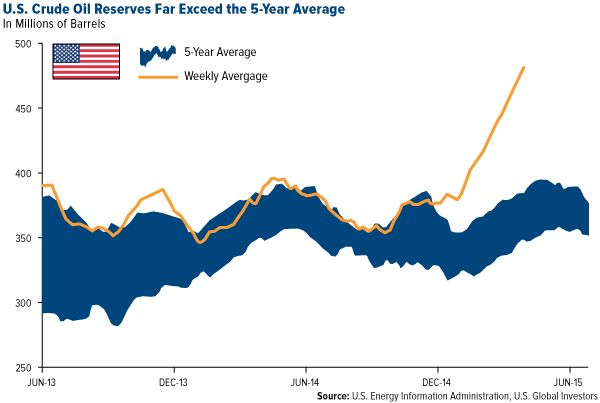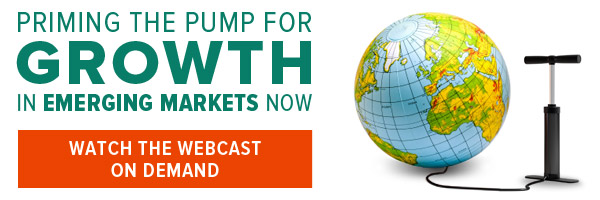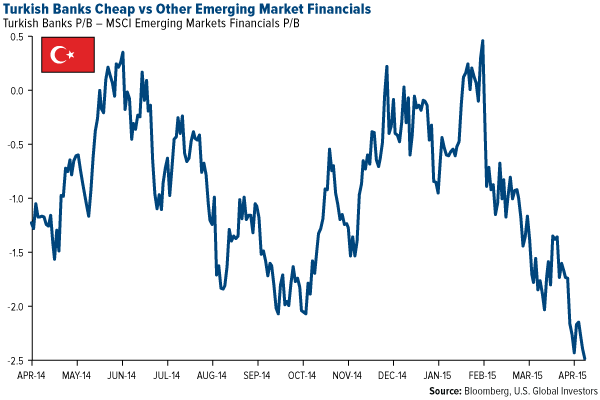By Frank Holmes
CEO and Chief Investment Officer
U.S. Global Investors
I’m going to begin with a bit of good news. Below is our China Region Fund (USCOX). As you can see, not only has it broken above its 50- and 200-day moving averages, but it’s also trading at four-year highs. And since this chart was created earlier in the week, the fund has climbed even higher.
As I mentioned last week, USCOX has benefited from the continued rally in the Shanghai Composite Index through our holdings in the Morgan Stanley China A Share Fund and a closed-end fund. The Shanghai Composite is up 87 percent year-over-year and is currently at a seven-year high.
So what’s the deal with Chinese equities right now? After all, China’s economic growth for the first quarter of the year cooled to a six-year low of 7 percent.
The market surge is mostly attributable to monetary easing and government policy changes such as housing stimulus and modernization of the country’s financial structure. But there’s more at work.
Saving Big on Commodities Slump
Also contributing to the bull run is the plunge in commodity prices since last June, brought on by both the strong U.S. dollar and a slowing global economy.
Such market conditions have obviously been a challenge for those involved in the production of raw materials and natural resources. But they’ve been a windfall for net-import countries, China included. Most of the beneficiaries are Asian and Eastern European nations—excluding Russia, whose economy largely depends on revenue generated from oil exports.
Besides Russia, the biggest losers have been Latin American countries, huge exporters of some of the hardest-hit resources—crude oil, sugar, soybeans and coffee.
As the world’s largest importer of natural resources, China saves an estimated $600 million a day on its oil import bill. That’s a staggering $200 billion a year. Low oil prices, in fact, should help boost GDP growth in the entire Asia-Pacific region between 0.25 and 0.5 percent, according to Rajiv Biswas, economist at consulting firm IHS Inc.
Low oil prices are also helping many businesses and companies such as American Airlines keep more capital in their coffers. For every $1 change in oil, American saves about $105 million per month in jet fuel costs, according to airline research analyst Helane Becker of financial services firm Cowen Group.
Amazingly enough, precious metals are the best-performing commodities sub-sector so far this year, having collectively lost 2.5 percent.
Of the 29 resources featured in the chart above, only red meat is in the black.
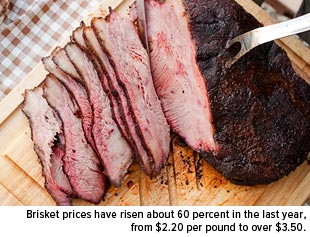 |
Whereas many of these commodities are facing oversupply issues, the cattle industry as well as barbeque purveyors are currently struggling with a brisket shortage, which have driven the wholesale price of the popular cut of meat up 60 percent from last year. Several barbeque joints here in San Antonio, in fact, have fallen victim this year to what the media are calling “the brisket bandit,” who’s made off with thousands of dollars’ worth of meat, both raw and smoked.
Platinum and palladium are fundamentally undervalued right now, and demand for both metals is expected to pick up this year. Low prices should spur platinum jewelry demand in China, while an increase in automobile sales in the U.S., eurozone and China should help palladium. (Palladium is used in the production of catalytic converters.)
The Start of Mergers and Acquisitions
The challenging crude oil environment has prompted the first of what will likely be a new wave of oil and gas company mergers and acquisitions (M&As) similar to what we last saw in the late 1990s. If you recall, Exxon merged with Mobil in an $80-billion deal, BP tied the knot with Amoco and Chevron bought Texaco.
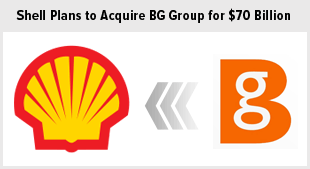 |
The current cycle kicked off last November when titan Halliburton agreed to purchase Baker Hughesfor $35 billion.
Now, for double that price in cash and stock, Royal Dutch Shell plans to gobble up UK-based BG Group in the biggest deal since the Exxon-Mobil merger. The combined companies will become the world’s largest producer of liquefied natural gas (LNG). Shell’s oil and gas reserves will grow 25 percent and give the company huge exposure to proven oilfields in Australia and Brazil. As is normally the case, the company being acquired sees a spike in share price, and BG is no exception; this week alone, its stock has risen more than 30 percent.
It’s doubtful we’ll see a deal this round as massive as Exxon-Mobil, but we expect more to occur among the junior to mid-tier producers and explorers.
Remembering Paul Reynolds
Today I’m in Toronto celebrating the life of my friend Paul Reynolds, premier broker in the resource world and former president and CEO of Canaccord Genuity, Canada’s largest independent investment bank. He passed away in Hawaii last Thursday following his competition in the Lavaman Waikoloa triathlon. He was 52.
 |
Paul was an early pioneer in the London Alternative Investment Market (AIM), which was a very successful platform for the creation of new companies, especially those involved in natural resources. During his tenure as chief executive, he turned Canaccord into a global operation through his balance of collaboration and competition. Besides being a highly-respected and transformative brokerage executive, my friend had an infectious zest for life. He was a seasoned participant in Olympic-length triathlons and other physically-demanding competitions.
Paul is survived by his wife, four children, and a large, tightknit extended family. They, along with his abundance of friends and colleagues, will remember the profound impact of his larger than life charisma and big heart. Paul will be deeply missed.
| One-Year | Five-Year | Ten-Year | Gross Expense Ratio |
Expense Cap |
|
| China Region Fund | 6.63% | 0.52% | 5.14% | 2.77% | 2.55% |
Expense ratios as stated in the most recent prospectus. The expense cap is a voluntary limit on total fund operating expenses (exclusive of any acquired fund fees and expenses, performance fees, taxes, brokerage commissions and interest) that U.S. Global Investors, Inc. can modify or terminate at any time, which may lower a fund’s yield or return. Performance data quoted above is historical. Past performance is no guarantee of future results. Results reflect the reinvestment of dividends and other earnings. For a portion of periods, the fund had expense limitations, without which returns would have been lower. Current performance may be higher or lower than the performance data quoted. The principal value and investment return of an investment will fluctuate so that your shares, when redeemed, may be worth more or less than their original cost. Performance does not include the effect of any direct fees described in the fund’s prospectus which, if applicable, would lower your total returns. Performance quoted for periods of one year or less is cumulative and not annualized. Obtain performance data current to the most recent month-end at www.usfunds.com or 1-800-US-FUNDS.
Index Summary
- The major market indices finished higher this week. The Dow Jones Industrial Average rose 1.66 percent. The S&P 500 Stock Index also gained 1.70 percent, while the Nasdaq Composite advanced 2.23 percent. The Russell 2000 small capitalization index rose 0.73 percent this week.
- The Hang Seng Composite gained 8.98 percent this week; while Taiwan rose 0.18 percent and the KOSPI advanced 2.89 percent.
- The 10-year Treasury bond yield rose 4 basis points to 1.95 percent.
Domestic Equity Market
The S&P 500 roared higher this week rising by 1.70 percent. Economically sensitive sectors led the way with industrials, energy and technology particularly strong performers. Interest rate sensitive areas of the market tended to underperform even though bond yields didn’t make any dramatic moves higher.
Strengths
- The industrials sector was the best performer this week, led by General Electric which rose by more than 14 percent as the company announced a restricting plan that included exiting most of the company’s lending and real estate operations and simultaneously announcing a massive $50 billion stock buyback.
- The energy sector was also a strong performer in the S&P 500 as almost every stock in the index rose this week. The sector was led by the offshore drillers, Transocean, Noble Corp, Ensco and Diamond Offshore. These stocks have been laggards and caught up some this week but with oil still mired around $50, near-term business prospects will still be weak.
- Perrigo was the best performer in the S&P 500, rising 21.27 percent this week but closely trailed by Mylan, which rose 20.91 percent. On Wednesday, Mylan made an unsolicited offer for Perrigo at a 23 percent premium and unusually both stocks rallied substantially on the news.
Weaknesses
- While every sector in the S&P 500 was positive for the week there were pockets of weakness. REITs underperformed, with many REIT areas falling by 2.5-3 percent on rising interest rate fears. The homebuilders suffered a similar fate for the same reason.
- Other areas of weakness included Bed Bath & Beyond which reported disappointing results and outlook. Freeport-McMoran was also weak on concerns of Chinese weakness in the mining sector.
- Hudson City Bancorp was the worst performer in the S&P 500 this week, falling 8.67 percent. The company is in the process of being acquired by M&T Bank, which said regulators won’t be able to complete a review of the proposed transaction by the April 30 deadline.
Opportunities
- The first-quarter earnings season kicks into high gear next week with JP Morgan, Intel, Goldman Sachs, Schlumberger and many more reporting next week.
- A strong dollar continues to benefit domestic consumers, maintaining an advantage for certain U.S.-focused retailers and consumer products.
- The market ended the week on a positive note and the bull market just keeps moving forward.
Threats
- The consumer appears confident but recent data points indicate some unexpected conservatism that could weigh on growth prospects.
- Biotechnology companies have been market darlings but may be showing their age.
- The Federal Reserve still appears to be on track for a late summer rate hike.
The Economy and Bond Market
U.S. Treasury bond yields moved higher this week as equities rallied and uncertainty over the timing of possible Fed tightening reversed last week’s gains. The employment report which was released on Good Friday showed unexpected weakness, but the market closed on Monday not far from Thursday’s close, so the market more or less just shrugged it off.
Strengths
- Job openings hit a 14-year high in February, which is another piece of evidence confirming the 5.5 percent unemployment rate and strengthening job market.
- Mortgage applications rose for the third week in a row and are at the highest level in almost two years.
- Auto sales in China rose 3.3 percent in March vs. a year ago to 2.24 million vehicles.
Weaknesses
- States with a concentration in the energy sector are seeing deteriorating economic optimism which may accelerate if other sectors can’t pick up the slack.
- Wholesale inventories rose 0.3 percent in February and remain at an elevated level relative to sales and are a potential early warning sign that the economy may be at risk.
- The U.S. dollar rallied against major currencies this week, potentially resuming the strong trend that began last year. The strong dollar is already having a negative impact on the export oriented manufacturing sector and could act as even more of a brake on the economy than many are currently expecting.
Opportunities
- European economic data is already on the mend and QE will just add fuel to the fire.
- China remains in monetary easing mode and more stimulus is likely.
- U.S. bond yields remain the highest in the developed world and funds will likely continue to flow into U.S. fixed income.
Threats
- One of the themes from the recent earnings season was that the strong U.S. dollar has negatively impacted companies’ bottom lines and capital spending plans. This will likely be the case for the first quarter as well. This negative impact could be seen this week in weak manufacturing data.
- The Fed seems almost determined to raise interest rates irrespective of the near term economic performance, raising the risk of a policy error.
- With a global easing cycle underway, global economic growth expectations have already started to improve, making it an easier decision for the Fed to possibly raise rates.
Gold Market
Since the Thursday before Good Friday, spot gold closed at $1,208.35, up $5.75 per ounce, or 0.48 percent. Gold stocks, as measured by the NYSE Arca Gold Miners Index, gained 2.23 percent. The U.S. Trade-Weighted Dollar Index gained 1.95 percent over the extended holiday period.
| Date | Event | Survey | Actual | Prior |
|---|---|---|---|---|
| Apr-9 | U.S. Initial Jobless Claims | 283K | 281K | 268K |
| Apr-14 | U.S. PPI Final Demand YoY | -0.90% | -- | -0.60% |
| Apr-14 | Chinese Retail Sales YoY | 10.90% | -- | -- |
| Apr-15 | German CPI YoY | 0.30% | -- | 0.30% |
| Apr-15 | ECB Main Refinancing Rate | 0.05% | -- | 0.05% |
| Apr-16 | U.S. Housing Starts | 1040K | -- | 897K |
| Apr-16 | U.S. Initial Jobless Claims | 280K | -- | 281K |
| Apr-17 | EU CPI Core YoY | 0.60% | -- | 0.60% |
| Apr-17 | U.S. CPI YoY | 0.00% | -- | 0.00% |
Strengths
- Gold rose for the first time in four days on Friday after holdings in exchange-traded products (ETPs) backed by bullion saw the largest increase in more than six weeks. Silver rose the most in a week.
- March gold imports for India came in at about 125 tons versus 60 tons a year ago. Furthermore, year-to-date (YTD) imports are at about 900 tons versus 662 tons the previous year.
- Several companies released positive drilling results and production updates this week. Klondex Mines announced that one of the veins drilled in its Midas Phase I program yielded 280.3 g/t of gold equivalent to over 1.5 meters. Lake Shore Gold’s first quarter preliminary gold production came in at 53,000 ounces, up 19 percent year-over-year. St. Barbara announced record gold production of 111,288 ounces in the first quarter of the year. Lastly, Claude Resources also set a quarterly record with production of 21,067 ounces.
Weaknesses
- Federal Reserve policy minutes released this week from their most recent meeting showed officials were split last month over whether they would raise interest rates in June. Short sellers used this as an opportunity to push gold down for a third day.
- Armed robbers walked away with an estimated $8.5 million of gold from the refinery at McEwen Mining’s El Gallo 1 Mine in Mexico’s Sinaloa state on Tuesday. The gold was contained in an estimated 900 kilograms of gold-bearing concentrate. The company announced that while it is insured, the policy won’t be enough to cover the entire expected loss. Apparently the furnace to produce the doré bars was offline for repairs, thus causing the gold concentrate to build up. This hints at the robbery being an inside job, with someone with knowledge of the buildup likely tipping off an outsider.
- Norilsk sees South African output of platinum declining in the next several years. With output already falling, however, it is troubling that there has not been a positive price response.
Opportunities
Furthermore, looking at the grade that has been processed (head grade) versus reserve grade, companies are currently processing close to reserve grade. Over the last five years, the average head grade is within 2 percent of reserve grade. Head grade in general has been seeing a decline in values since 2001 but dropped abruptly in 2005, forcing companies to struggle to keep their operations profitable.
- In a new report, RBC Capital Markets analysts identify three phases gold miners have historically gone through in response to low commodity prices: rationalization, restructuring and refinancing. Their view is that we are still in the rationalization phase, when management teams think prices will recover in the near term. Given this outlook, they respond to market conditions with “temporary fixes” such as cuts to sustaining capital. However, as we move into the restructuring phase, there is an uptick in insolvencies and mergers, and in the refinancing phase, optimism ticks up and well-financed companies try to consolidate mining camps. The RBC analysts believe these latter phases are coming soon.
- Goldman Sachs published a report warning that capex cuts could threaten future production. In response to the multiyear commodity price correction, gold miners globally have cut capex by 52 percent since year-end 2012, which Goldman forecasts will drive a 7-percent decline in production by 2018 from today’s levels.
- Bank of America/Merrill Lynch published a report in which they argue that while producers have been focused on maximizing free cash flow from operations, there is a concern that not enough attention is being paid to the declining reserves trend. The average reserve life index for the North American gold producers has plunged 23 percent from 13 years ago at year-end 2012 to 10.2 years at year-end 2014.
- This relates to a study from Scotiabank, illustrated in the chart above, that argues the decline in reserves in 2014 came about mainly because companies did not replace depletion as the gold price used for reserve analysis was flat.
Threats
- India is the world’s biggest consumer of gold, and its ancient temples have collected billions of dollars in jewelry, bars and coins over the centuries which are hidden securely in vaults. Now the government plans to get its hands on this temple of gold, estimated at about 3,000 tons, to help tackle India’s chronic trade imbalance. Prime Minister Narendra Modi’s government is planning to launch a scheme in May that would encourage temples to deposit their gold with banks in return for interest payments. The government would melt the gold and loan it to jewelers to meet an insatiable appetite for gold and reduce economically crippling gold imports. Key to Modi’s plan will be the interest rates offered for gold deposits. If India can cut imports, that would pressure gold prices that fell to a four-month low last month before recovering.
- In Greece, hundreds of supporters and opponents of Eldorado Gold’s mining operation clashed despite police efforts to separate them. Police said more than 2,000 supporters and 850 opponents were involved. The mine operation has sharply divided residents, with some fearing environmental damage and a drop in tourism. Others welcome the nearly 2,000 jobs it provides at a time of economic crisis.
- The Greek energy minister derided Eldorado Gold, saying the company “can’t act like a state within a state.” It said the government won’t be blackmailed and condemned the blocking of roads by Eldorado workers during Easter period.
Energy and Natural Resources Market
Strengths
- Oil and gas drilling stocks outperformed this week alongside a nice bounce in crude oil prices. WTI crude rose 5.37 percent this week, while the S&P Supercomposite Oil & Gas Drilling Index rose 7.15 percent.
- Tanker stocks continued their rally this week as global growth prospects continued to strengthen due to global easing. The Bloomberg News Tanker Index rose 5.46 percent this week.
- Canadian metals and mining stocks outperformed this week as investors expect more action out of China to stimulate growth. The S&P/TSX Diversified Capped Metals and Mining Index rose 3.39 percent this week.
Weaknesses
- Utilities stocks were a relative underperformer as investors poured into more cyclical areas. The S&P 500 Utilities Index rose 0.20 percent this week.
- Construction materials stocks, which had a significant bounce in February, were a relative laggard this week. The S&P Supercomposite Construction and Materials Index rose 0.36 percent this week.
- Oil and gas refiners were a relative underperformer this week as the gap between WTI and Brent crude oil continued to shrink. The S&P Supercomposite Oil & Gas Refining & Marketing Index rose 0.55 percent this week.
Opportunities
- Copper prices are trying to breaking out of the bear market the commodity experienced in the back half of 2014. Further economic stimulus from China and globally should boost the struggling commodity.
- The global environment has all but fully evolved into an easing one. Multiple countries have cut interest rates or stimulated their economies through other means over the past few months, leading to a more synchronized growth strategy. If successful, these government policies should aid commodity demand.
- The Baker Hughes United States crude oil rig count fell again this week to 760. With the rig count continuing to fall, it is only a matter of time before crude oil begins its steady rise.
Threats
- The dollar rose every single day this week, disrupting what could have potentially been the beginning of a downward cycle. The dollar closed up 2.93 percent this week.
- The Iran framework deal creates more uncertainty surrounding the global supply of crude oil and, if not offset by production cuts elsewhere, could cause oil prices to retreat.
- Natural gas, in sharp contrast to crude oil, has failed to see any sign of a shift in momentum as prices continue to fall due to an unfavorable weather outlook.
Emerging Markets
Strengths
- Chinese H-shares had a tremendous run this week as they raced to catch up with their A-share counterparts, on expectations of further stimulus from the government. The Hang Seng Composite Index rose 8.98 percent this week.
- Hungarian equities continued to be a strong relative outperformer as the country received residual benefits from the eurozone’s easing program. The Budapest Stock Exchange Index rose 5.75 percent this week.
- Indian equities rallied this week as February’s industrial production data rose 5 percent against an expected 3 percent increase. The S&P BSE Sensex Index rose 2.19 percent this week.
Weaknesses
- Russian equities underperformed this week despite a rally in the ruble and crude oil. The MICEX Index fell 1.45 percent this week.
- Turkish equities and the Lira continued their downward trend this week as the country’s growth outlook remained disappointing and investors continue to fear the coming rate hike in the United States. The Borsa Istanbul 100 Index fell 0.42 percent this week while the lira fell 2.27 percent.
- Emerging European currencies continued to decline as the European Central Bank’s stimulus program floods the region with liquidity. The Hungarian forint, the Czech koruna and the Polish zloty fell 2.72, 2.90, and 2.48 percent, respectively, against the dollar this week.
Opportunities
- Bloomberg released a report detailing how cheap Turkish banks are relative to other emerging market financial companies in terms of price-to-book ratios. While this relatively cheap valuation of Turkish banks could be an opportunity to buy cheap quality companies it should be carefully considered.
- Many Asia analysts are forecasting further rate cuts out of Thailand as a response to declining exports and deflationary pressures. Further stimulus in the regions should be positive for synchronized global growth.
- Moody’s Investors Service and Fitch Ratings elevated their respective growth forecasts for India this week. Both rating agencies maintain an investment grade for India and expect the government led reforms to positively impact economic growth.
Threats
- The dollar’s rally is weighing on Poland as foreign investors dump their holdings of zloty-denominated assets. The government still requires 43 percent of the funding required for 2015, leaving the assets vulnerable to any further decline in demand for government debt.
- Deutsche Bank is predicting the euro will reach parity with the dollar by the end of this year and fall to 90 cents in 2016. Divergence in monetary policy, according to the bank, should continue to weigh on the euro relative to the dollar.
Leaders and Laggards
| Index | Close | Weekly Change($) |
Weekly Change(%) |
|---|---|---|---|
| DJIA | 18,057.65 | +294.41 | +1.66% |
| S&P 500 | 2,102.06 | +35.10 | +1.70% |
| S&P Energy | 585.36 | +17.57 | +3.09% |
| S&P Basic Materials | 311.81 | +4.58 | +1.49% |
| Nasdaq | 4,995.98 | +109.04 | +2.23% |
| Russell 2000 | 1,264.76 | +9.11 | +0.73% |
| Hang Seng Composite Index | 3,838.14 | +316.33 | +8.98% |
| Korean KOSPI Index | 2,087.76 | +58.69 | +2.89% |
| S&P/TSX Canadian Gold Index | 165.88 | +3.68 | +2.27% |
| XAU | 69.27 | +1.31 | +1.93% |
| Gold Futures | 1,207.70 | +6.80 | +0.57% |
| Oil Futures | 51.73 | +2.59 | +5.27% |
| Natural Gas Futures | 2.51 | -0.20 | -7.45% |
| 10-Yr Treasury Bond | 1.95 | +0.04 | +2.04% |
| Index | Close | Monthly Change($) |
Monthly Change(%) |
|---|---|---|---|
| DJIA | 18,057.65 | +422.26 | +2.39% |
| S&P 500 | 2,102.06 | +61.82 | +3.03% |
| S&P Energy | 585.36 | +35.39 | +6.43% |
| S&P Basic Materials | 311.81 | +0.61 | +0.20% |
| Nasdaq | 4,995.98 | +146.04 | +3.01% |
| Russell 2000 | 1,264.76 | +48.99 | +4.03% |
| Hang Seng Composite Index | 3,838.14 | -332.01 | -14.83% |
| Korean KOSPI Index | 2,087.76 | +106.93 | +5.40% |
| S&P/TSX Canadian Gold Index | 165.88 | +6.90 | +4.34% |
| XAU | 69.27 | +3.30 | +5.00% |
| Gold Futures | 1,207.70 | +56.10 | +4.87% |
| Oil Futures | 51.73 | +3.56 | +7.39% |
| Natural Gas Futures | 2.51 | -0.31 | -11.08% |
| 10-Yr Treasury Bond | 1.95 | -0.16 | -7.49% |
| Index | Close | Quarterly Change($) |
Quarterly Change(%) |
|---|---|---|---|
| DJIA | 18,057.65 | +320.28 | +1.81% |
| S&P 500 | 2,102.06 | +57.25 | +2.80% |
| S&P Energy | 585.36 | +17.44 | +3.07% |
| S&P Basic Materials | 311.81 | +7.74 | +2.55% |
| Nasdaq | 4,995.98 | +291.91 | +6.21% |
| Russell 2000 | 1,264.76 | +79.09 | +6.67% |
| Hang Seng Composite Index | 3,838.14 | +524.54 | +15.83% |
| Korean KOSPI Index | 2,087.76 | +163.06 | +8.47% |
| S&P/TSX Canadian Gold Index | 165.88 | -0.36 | -0.22% |
| XAU | 69.27 | -6.90 | -9.06% |
| Gold Futures | 1,207.70 | -9.90 | -0.81% |
| Oil Futures | 51.73 | +3.37 | +6.97% |
| Natural Gas Futures | 2.51 | -0.44 | -14.77% |
| 10-Yr Treasury Bond | 1.95 | +0.01 | +0.26% |
Please consider carefully a fund’s investment objectives, risks, charges and expenses. For this and other important information, obtain a fund prospectus by visiting www.usfunds.com or by calling 1-800-US-FUNDS (1-800-873-8637). Read it carefully before investing. Distributed by U.S. Global Brokerage, Inc.
All opinions expressed and data provided are subject to change without notice. Some of these opinions may not be appropriate to every investor.
Foreign and emerging market investing involves special risks such as currency fluctuation and less public disclosure, as well as economic and political risk. By investing in a specific geographic region, a regional fund’s returns and share price may be more volatile than those of a less concentrated portfolio.
The Emerging Europe Fund invests more than 25 percent of its investments in companies principally engaged in the oil & gas or banking industries. The risk of concentrating investments in this group of industries will make the fund more susceptible to risk in these industries than funds which do not concentrate their investments in an industry and may make the fund’s performance more volatile.
Because the Global Resources Fund concentrates its investments in a specific industry, the fund may be subject to greater risks and fluctuations than a portfolio representing a broader range of industries.
Gold, precious metals, and precious minerals funds may be susceptible to adverse economic, political or regulatory developments due to concentrating in a single theme. The prices of gold, precious metals, and precious minerals are subject to substantial price fluctuations over short periods of time and may be affected by unpredicted international monetary and political policies. We suggest investing no more than 5 percent to 10 percent of your portfolio in these sectors.
Bond funds are subject to interest-rate risk; their value declines as interest rates rise. Tax-exempt income is federal income tax free. A portion of this income may be subject to state and local income taxes, and if applicable, may subject certain investors to the Alternative Minimum Tax as well. The Near-Term Tax Free Fund may invest up to 20% of its assets in securities that pay taxable interest. Income or fund distributions attributable to capital gains are usually subject to both state and federal income taxes. The Near-Term Tax Free Fund may be exposed to risks related to a concentration of investments in a particular state or geographic area. These investments present risks resulting from changes in economic conditions of the region or issuer.
Investing in real estate securities involves risks including the potential loss of principal resulting from changes in property value, interest rates, taxes and changes in regulatory requirements.
Past performance does not guarantee future results.
Some link(s) above may be directed to a third-party website(s). U.S. Global Investors does not endorse all information supplied by this/these website(s) and is not responsible for its/their content.
These market comments were compiled using Bloomberg and Reuters financial news.
Fund portfolios are actively managed, and holdings may change daily. Holdings are reported as of the most recent quarter-end. Holdings as a percentage of net assets as of March 31, 2015:
IHS Inc.: 0.00%
American Airlines: 0.00%
Exxon Mobil Corp: All American Equity Fund, 1.06%, Global Resources Fund, 3.13%
BP PLC: Global Resources Fund, 2.99%
Chevron Corp: Global Resources Fund, 3.06%
Halliburton: 0.00%
Baker Hughes Inc.: Global Resources Fund, 0.23%
Royal Dutch Shell PLC: Global Resources Fund, 2.97%
BG Group: 0.00%
Canaccord Genuity Group Inc.: 0.11%
General Electric: 0.00%
Transocean: 0.00%
Noble Corp: 0.00%
Diamond Offshore Drilling: All American Equity Fund, 0.81%
Ensco PLC: All American Equity Fund, 0.82%
Perrigo: 0.00%
Mylan NV: Holmes Macro Trends Fund, 2.55%
Bed, Bath & Beyond: 0.00%
Freeport MacMoran: 0.00%
Hudson City Bancorp: 0.00%
JP Morgan Chase & Co: All American Equity Fund, 1.20%
Intel Corp: All American Equity Fund, 0.90%
Goldman Sachs: 0.00%
Schlumberger Ltd: All American Equity Fund, 1.12%
RBC Capital: 0.00%
McEwen Mining: 0.00%
Klondex Mines Ltd: Global Resources Fund, 2.27%; Gold and Precious Metals Fund, 12.37%; World Precious Minerals Fund, 13.18%
Lake Shore Gold Corp: Gold and Precious Metals Fund, 2.27%; World Precious Minerals Fund, 0.86%
St. Barbara Ltd: Gold and Precious Metals Fund, 0.27%; World Precious Minerals Fund, 0.19%
Claude Resources Inc: Gold and Precious Metals Fund, 0.96%; World Precious Minerals Fund, 0.41%
Norilsk: 0.00%
Eldorado Gold Corp: Gold and Precious Metals Fund, 0.06%; World Precious Minerals Fund, 0.06%
*The above-mentioned indices are not total returns. These returns reflect simple appreciation only and do not reflect dividend reinvestment.
The Dow Jones Industrial Average is a price-weighted average of 30 blue chip stocks that are generally leaders in their industry.
The S&P 500 Stock Index is a widely recognized capitalization-weighted index of 500 common stock prices in U.S. companies.
The Nasdaq Composite Index is a capitalization-weighted index of all Nasdaq National Market and SmallCap stocks.
The Russell 2000 Index® is a U.S. equity index measuring the performance of the 2,000 smallest companies in the Russell 3000®, a widely recognized small-cap index.
The Hang Seng Composite Index is a market capitalization-weighted index that comprises the top 200 companies listed on Stock Exchange of Hong Kong, based on average market cap for the 12 months.
The Taiwan Stock Exchange Index is a capitalization-weighted index of all listed common shares traded on the Taiwan Stock Exchange.
The Korea Stock Price Index is a capitalization-weighted index of all common shares and preferred shares on the Korean Stock Exchanges.
The Philadelphia Stock Exchange Gold and Silver Index (XAU) is a capitalization-weighted index that includes the leading companies involved in the mining of gold and silver.
The U.S. Trade Weighted Dollar Index provides a general indication of the international value of the U.S. dollar.
The S&P/TSX Canadian Gold Capped Sector Index is a modified capitalization-weighted index, whose equity weights are capped 25 percent and index constituents are derived from a subset stock pool of S&P/TSX Composite Index stocks.
The S&P 500 Energy Index is a capitalization-weighted index that tracks the companies in the energy sector as a subset of the S&P 500.
The S&P 500 Materials Index is a capitalization-weighted index that tracks the companies in the material sector as a subset of the S&P 500.
The S&P 500 Financials Index is a capitalization-weighted index. The index was developed with a base level of 10 for the 1941-43 base period.
The S&P 500 Industrials Index is a Materials Index is a capitalization-weighted index that tracks the companies in the industrial sector as a subset of the S&P 500.
The S&P 500 Consumer Discretionary Index is a capitalization-weighted index that tracks the companies in the consumer discretionary sector as a subset of the S&P 500.
The S&P 500 Information Technology Index is a capitalization-weighted index that tracks the companies in the information technology sector as a subset of the S&P 500.
The S&P 500 Consumer Staples Index is a Materials Index is a capitalization-weighted index that tracks the companies in the consumer staples sector as a subset of the S&P 500.
The S&P 500 Utilities Index is a capitalization-weighted index that tracks the companies in the utilities sector as a subset of the S&P 500.
The S&P 500 Healthcare Index is a capitalization-weighted index that tracks the companies in the healthcare sector as a subset of the S&P 500.
The S&P 500 Telecom Index is a Materials Index is a capitalization-weighted index that tracks the companies in the telecom sector as a subset of the S&P 500.
The NYSE Arca Gold Miners Index is a modified market capitalization weighted index comprised of publicly traded companies involved primarily in the mining for gold and silver.
The Consumer Price Index (CPI) is one of the most widely recognized price measures for tracking the price of a market basket of goods and services purchased by individuals. The weights of components are based on consumer spending patterns.
The Shanghai Composite Index (SSE) is an index of all stocks that trade on the Shanghai Stock Exchange.
The S&P Supercomposite Oil & Gas Drilling Index is a capitalization-weighted index.
S&P/TSX Capped Diversified Metals and Mining Index is an index of companies engaged in diversified production or extraction of metals and minerals.
The Bloomberg Tanker Index is an index of dirty tanker operating companies.
The S&P Supercomposite Construction and Materials Index is a capitalization-weighted index.
S&P Supercomposite Oil & Gas Refining & Marketing Index is a capitalization-weighted index.
The Borsa Istanbul Banks Index (XBANK) is a capitalization-weighted free float adjusted Industry Group Index composed of National Market listed companies in the banking industry. All members of the index are also constituents of the XUMAL Sector Index.
The Budapest Stock Exchange Index is a capitalization-weighted index adjusted for free float. The index tracks the daily price-only performance of large, actively traded shares on the Budapest Stock Exchange.
The MICEX Index is the real-time cap-weighted Russian composite index. It comprises 30 most liquid stocks of Russian largest and most developed companies from 10 main economy sectors. The MICEX Index was launched on September 22, 1997, base value 100. The MICEX Index is calculated and disseminated by the MICEX Stock Exchange, the main Russian stock exchange.
The S&P BSE SENSEX Index is a free-float market-weighted stock market index of 30 well-established and financially sound companies listed on the Bombay Stock Exchange.






